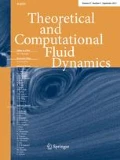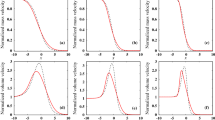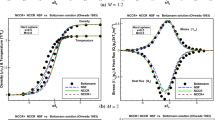Abstract
Linear instability of high-speed boundary layers is routinely examined assuming quiescent edge conditions, without reference to the internal structure of shocks or to instabilities potentially generated in them. Our recent work has shown that the kinetically modeled internal nonequilibrium zone of straight shocks away from solid boundaries exhibits low-frequency molecular fluctuations. The presence of the dominant low frequencies observed using the direct simulation Monte Carlo (DSMC) method has been explained as a consequence of the well-known bimodal probability density function (PDF) of the energy of particles inside a shock. Here, PDFs of particle energies are derived in the upstream and downstream equilibrium regions, as well as inside shocks, and it is shown for the first time that they have the form of the noncentral Chi-squared (NCCS) distributions. A linear correlation is proposed to relate the change in the shape of the analytical PDFs at a specified upstream number density and temperature as a function of Mach number, within the range \(3 \le M \le 10\), with the DSMC-derived average characteristic low-frequency of shocks, as computed in our earlier work. At a given Mach number \(M=7.2\) and upstream number density \(n_1=10^{22}\,\hbox {m}^{-3}\), it is shown that the variation in DSMC-derived low frequencies is correlated with the change in most-probable-speed inside shocks at the location of maximum bulk velocity gradient for upstream translational temperature in the range \(\sim 90 \le T_{tr,1}/(K) \le 1420\). Using the proposed linear functions, average low frequencies are estimated within the examined ranges of Mach number and input temperature and a semi-empirical relationship is derived to predict low-frequency oscillations in shocks. Our model can be used to provide realistic physics-based boundary conditions in receptivity and linear stability analysis studies of laminar-turbulent transition in high-speed flows.






Similar content being viewed by others
Notes
Appendix provides a python function to generate these PDFs.
References
Schneider, S.P.: Hypersonic laminar-turbulent transition on circular cones and scramjet forebodies. Prog. Aerosp. Sci. 40(1–2), 1 (2004). https://doi.org/10.1016/j.paerosci.2003.11.001
Morkovin, M.V.: Critical evaluation of transition from laminar to turbulent shear layers with emphasis on hypersonically travelling bodies Critical evaluation of transition from laminar to turbulent shear layers with emphasis on hypersonically travelling bodies. Tech. Rep. AFFDL-TR-68-149, Air Force Flight Dynamics Laboratory (1969)
Potter, J.L.: Observations on the influence of ambient pressure on boundary-layer transition. AIAA J. 6(10), 1907 (1968). https://doi.org/10.2514/3.4899
Pate, S.R.: Measurements and correlations of transition Reynolds numbers on sharp slender cones at high speeds. AIAA J. 9(6), 1082 (1971). https://doi.org/10.2514/3.49919
Schneider, S.P.: Effects of high-speed tunnel noise on laminar-turbulent transition. J. Spacecr. Rocket. 38(3), 323 (2001). https://doi.org/10.2514/6.2000-2205
Wagner, A., Schülein, E., Petervari, R., Hannemann, K., Ali, S.R.C., Cerminara, A., Sandham, N.D.: Combined free-stream disturbance measurements and receptivity studies in hypersonic wind tunnels by means of a slender wedge probe and direct numerical simulation. J. Fluid Mech. 842, 495–531 (2018). https://doi.org/10.1017/jfm.2018.132
Balakumar, P., Chou, A.: Transition prediction in hypersonic boundary layers using receptivity and freestream spectra. AIAA J., pp. 193–208 (2018). https://doi.org/10.2514/1.J056040
Hader, C., Fasel, H.F.: Towards simulating natural transition in hypersonic boundary layers via random inflow disturbances. J. Fluid Mech. 847, R3 (2018). https://doi.org/10.1017/jfm.2018.386
Lee, S., Lele, S.K., Moin, P.: Interaction of isotropic turbulence with shock waves: effect of shock strength. J. Fluid Mech. 340, 225 (1997). https://doi.org/10.1017/S0022112097005107
Zhong, X.: High-order finite-difference schemes for numerical simulation of hypersonic boundary-layer transition. J. Comput. Phys. 144(2), 662 (1998). https://doi.org/10.1006/jcph.1998.6010
Sawant, S.S., Levin, D.A., Theofilis, V.: A kinetic approach to studying low-frequency molecular fluctuations in a one-dimensional shock (2020). Submitted to Phys. Fluids, arXiv: 2012.14593
Fedorov, A., Tumin, A.: Receptivity of high-speed boundary layers to kinetic fluctuations. AIAA J. 55(7), 2335 (2017). https://doi.org/10.2514/1.J055326
Luchini, P.: A thermodynamic lower bound on transition-triggering disturbances, in Seventh IUTAM. In: Symposium on Laminar-Turbulent Transition, Springer , pp. 11–18 (2010)
Landau, L.D., Lifshitz, E.M.: Statistical Physics: Part 1, vol. 5, 3rd edn. Pergamon Press, Oxford (1980)
Marineau, E.C., Moraru, G.C., Lewis, D.R., Norris, J.D., Lafferty, J.F., Johnson, H.B.: Investigation of Mach 10 boundary layer stability of sharp cones at angle-of-attack, part 1: experiments. Presented at the (2015). https://doi.org/10.2514/6.2015-1737
Chynoweth, B., Ward, C., Henderson, R., Moraru, C., Greenwood, R., Abney, A., Schneider, S.: Transition and instability measurements in a Mach 6 hypersonic quiet wind tunnel. AIAA Paper 75,(2014). https://doi.org/10.2514/6.2014-0074
Ma, Y., Zhong, X.: Receptivity of a supersonic boundary layer over a flat plate. Part 1. Wave structures and interactions. J. Fluid Mech. 488, 31 (2003). https://doi.org/10.1017/S0022112003004786
Ma, Y., Zhong, X.: Receptivity of a supersonic boundary layer over a flat plate. Part 2. Receptivity to free-stream sound. J. Fluid Mech. 488, 79 (2003). https://doi.org/10.1017/S0022112003004798
Ma, Y., Zhong, X.: Receptivity of a supersonic boundary layer over a flat plate. Part 3. Effects of different types of free-stream disturbances. J. Fluid Mech. 532, 63 (2005). https://doi.org/10.1017/S0022112005003836
Laurendeau, N.M.: Statistical Thermodynamics: Fundamentals and Applications. Cambridge University Press, Cambridge (2005)
Vincenti, W.G., Kruger, C.H.: Introduction to Physical Gas Dynamics. Wiley, New York (1965)
Bird, G.A.: Molecular Gas Dynamics and the Direct Simulation of Gas Flows, 2nd edn. Clarendon Press, UK (1994)
Mott-Smith, H.M.: The solution of the Boltzmann equation for a shock wave. Phys. Rev. 82, 885 (1951). https://doi.org/10.1103/PhysRev.82.885
Sharipov, F.: Rarefied Gas Dynamics: Fundamentals for Research and Practice. Wiley, New York (2015)
András, S., Baricz, Á.: Properties of the probability density function of the non-central chi-squared distribution. J. Math. Anal. Appl. 346(2), 395 (2008). https://doi.org/10.1016/j.jmaa.2008.05.074
SciPy-1.5.1, https://docs.scipy.org/doc/scipy/reference/generated/scipy.signal.welch.html
Welch, P.: The use of fast Fourier transform for the estimation of power spectra: a method based on time averaging over short, modified periodograms. IEEE Trans. Audio Electroacoust. 15(2), 70 (1967). https://doi.org/10.1109/TAU.1967.1161901
Solomon Jr. O.M.: PSD computations using Welch’s method. Tech. Rep. SAND-91-1533 ON: DE92007419, Sandia National Laboratories., Albuquerque, NM (1991). https://doi.org/10.2172/5688766
Acknowledgements
The research conducted in this paper is supported by the Office of Naval Research under the grant No. N000141202195 titled, ‘Multi-scale modeling of unsteady shock-boundary layer hypersonic flow instabilities.’ This work used the STAMPEDE2 supercomputing resources provided by the Extreme Science and Engineering Discovery Environment (XSEDE) at the Texas Advanced Computing Center (TACC) through allocation TG-PHY160006.
Author information
Authors and Affiliations
Corresponding author
Ethics declarations
Data Availability Statement
The datasets generated during and/or analyzed during the current study are available from the corresponding author on reasonable request.
Additional information
Communicated by Pino Martin.
Publisher's Note
Springer Nature remains neutral with regard to jurisdictional claims in published maps and institutional affiliations.
A python code for generating the bimodal NCCS PDFs
A python code for generating the bimodal NCCS PDFs
This appendix gives the code snippet for generating bimodal NCCS distribution. The values of code variables ‘R,’ ‘Ux1,’ ‘Ttr1,’ ‘beta1,’ ‘Ux2,’ ‘Ttr2,’ ‘beta2’ are 208.243, 3572.24, 710, \(1.849 \times 10^{-3}\), 944.74, 12120.6, \(4.451 \times 10^{-4}\), respectively. The values of code variables ‘Ux,’ ‘Ttr,’ ‘beta’ are obtained from the Mott-Smith velocity distribution and equal to 2012.8, 10149.8, \(4.864\times 10^{-3}\), respectively, at probe P. The code variables ‘psi1’ and ‘psi2’ are Mott-Smith fractions and equal to 0.40649 and 0.59351, respectively, at probe P.

Rights and permissions
About this article
Cite this article
Sawant, S.S., Levin, D.A. & Theofilis, V. Analytical prediction of low-frequency fluctuations inside a one-dimensional shock. Theor. Comput. Fluid Dyn. 36, 25–40 (2022). https://doi.org/10.1007/s00162-021-00589-5
Received:
Accepted:
Published:
Issue Date:
DOI: https://doi.org/10.1007/s00162-021-00589-5




